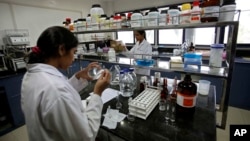NEW DELHI —
As the Indian drug industry comes under greater scrutiny for quality lapses, U.S. regulators have called for better compliance with production standards. India is a huge supplier of prescription drugs to the U.S.
Concerns about the quality of medicines exported by India came to the forefront last year after a leading Indian drug company, Ranbaxy, pleaded guilty to falsifying clinical data and distributing adulterated medicines in the U.S.
The U.S. Food and Drug Administration (FDA) has banned drug imports from Ranbaxy’s Indian plants and some drugs from another company, Wockhardt.
As U.S. FDA commissioner Margaret Hamburg wrapped up a nine-day visit to India this week, she stressed the need for India’s drug industry to ensure that the medicines it exports are safe.
Although the concerns have been triggered by a handful of companies, it has affected the image of the Indian pharmaceutical industry. India’s industry has boomed on the back of the low cost drugs it makes and exports to both developing and developed countries. In total, Indian drug exports are worth about $15 billion.
The secretary general of the Indian Pharmaceutical Alliance, D.G. Shah, said drug companies are taking steps to comply with U.S. standards.
“We are sensitizing organizations and CEO’s themselves have to be alert about the culture change they have to bring in organizations. Jointly with U.S. FDA we will organize seminars in India where Indian companies will be exposed to standards and requirements, how to achieve those,” said Shah.
The U.S. FDA's Hamburg has called on Indian regulators to join the U.S. in ensuring more rigorous oversight of drug manufacturing facilities. Hamburg said the industry plays an important role in the global marketplace.
For its part, the U.S. will increase the number of FDA inspectors in India from 11 to 19 as it intensifies inspections of drug factories. India also plans to increase its staff of inspectors from 1,500 to 5,000 over the next five years.
However, Shah said, while some problems have been identified by the U.S. regulator, most Indian drug manufacturing facilities are world class. He said the issue should not be blown out of proportion.
“We need to put our house in order first and this is something which is being addressed. Media should not be alarmist about what happens to one or two companies out of 300 companies which are exporting to U.S.,” said Shah.
Even as fingers are pointed at a lax approach to quality control by some drug-makers in India, the U.S. concerns are likely to serve as a wake-up call.
Some 40 percent of prescription and over the counter drugs sold in the United States come from India. Most of them are cheaper versions of medicines whose patents have expired.
Concerns about the quality of medicines exported by India came to the forefront last year after a leading Indian drug company, Ranbaxy, pleaded guilty to falsifying clinical data and distributing adulterated medicines in the U.S.
The U.S. Food and Drug Administration (FDA) has banned drug imports from Ranbaxy’s Indian plants and some drugs from another company, Wockhardt.
As U.S. FDA commissioner Margaret Hamburg wrapped up a nine-day visit to India this week, she stressed the need for India’s drug industry to ensure that the medicines it exports are safe.
Although the concerns have been triggered by a handful of companies, it has affected the image of the Indian pharmaceutical industry. India’s industry has boomed on the back of the low cost drugs it makes and exports to both developing and developed countries. In total, Indian drug exports are worth about $15 billion.
The secretary general of the Indian Pharmaceutical Alliance, D.G. Shah, said drug companies are taking steps to comply with U.S. standards.
“We are sensitizing organizations and CEO’s themselves have to be alert about the culture change they have to bring in organizations. Jointly with U.S. FDA we will organize seminars in India where Indian companies will be exposed to standards and requirements, how to achieve those,” said Shah.
The U.S. FDA's Hamburg has called on Indian regulators to join the U.S. in ensuring more rigorous oversight of drug manufacturing facilities. Hamburg said the industry plays an important role in the global marketplace.
For its part, the U.S. will increase the number of FDA inspectors in India from 11 to 19 as it intensifies inspections of drug factories. India also plans to increase its staff of inspectors from 1,500 to 5,000 over the next five years.
However, Shah said, while some problems have been identified by the U.S. regulator, most Indian drug manufacturing facilities are world class. He said the issue should not be blown out of proportion.
“We need to put our house in order first and this is something which is being addressed. Media should not be alarmist about what happens to one or two companies out of 300 companies which are exporting to U.S.,” said Shah.
Even as fingers are pointed at a lax approach to quality control by some drug-makers in India, the U.S. concerns are likely to serve as a wake-up call.
Some 40 percent of prescription and over the counter drugs sold in the United States come from India. Most of them are cheaper versions of medicines whose patents have expired.







